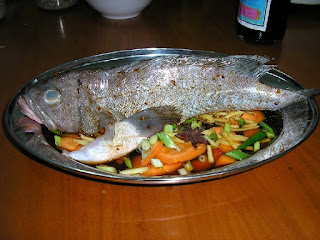A paddy field located in Perlis, Malaysia.

There are 2 different kinds of rice to choose from, polished and unpolished rice. The popular choice is the polished rice. It is nearly white in colour and free of impurities, which is the reason why it is popular as compared to the dull colour of unpolished rice. Unpolished rice is full of impurities which are actually nutritious for us. Unpolished rice is gaining popularity with many health advocates due to the nutritional content. There are varieties of rice and some are as expensive up to the point of RM8.00 per kilogram. Apart from polished and unpolished rice, rice is differentiated by their grain size, nutritional properties and the place they originated from.
American rice is short grained, cheap and contains loads of starch which is economical for restaurants. The Basmati rice, the grade A rice and high in nutrition yield after can cost up to RM7.00 per kilogram. Thai fragrant rice is a long grain rice from Thailand which gives a very fragrant aroma after cooking and glutinous rice which is high in starch and perfect for making rice dumplings. You can find most of the popular rice at any local departmental store and is sold in different packing from 1kg to 20kg packs.
Rice is the staple food of most parts in Asia and is prepared and eaten differently depending on culture. In India, rice is cooked wtih sufficient water in electric cookers or pots under wood fire until fully cooked and is served either piping hot or warm on a banana leaf that magnifies the aroma. They also cook rice in a special procedure of sautéing with ghee, spices and vegetables and cooked in sufficient water and yoghurt. This recipe is called Bryanni rice with different variations of meat and seafood cooked together with the rice. This is an equivalent of Paella from Spain or Jambalaya from South Africa. In Japan, rice is steam cooked and served in bowls and chopsticks and glutinous rice is used to make sushi.
In Malaysia, rice is cooked in a lot of water which is called congee or porridge and there are different variations of it too from chicken porridge to oyster porridge. The best porridge is prepared by the Teochew Chinese which originated from China and is one of the many peasant food made into a gourmet food and fast food. McDonald's in Malaysia sells chicken porridge which is now widely accepted and enjoyed by other races. In the UK and Malaysia, rice is made into rice pudding as dessert.
Rice pudding dessert (UK style). Chinese style is different.

While I was studying in UK for my degree, I saw my hostel mate cooked rice by boiling them in water and then strain all the water off before eating. I even had the opportunity to try frozen fried rice and frozen Thai green curry rice which is prepared by heating them up in the microwave. It tastes just like freshly cooked rice and even the texture is the same. There are even rice in pre-packed food grade safe plastics which are prepared by boiling them up in water and then drain the water off as the wrapping have small holes which made life much comfortable. I have to admit that the plastic pre-packed rice is my favourite as you can prepare them in under 5 minutes. Rice is being creatively prepared all over the world and being accepted in nearly every country as either a source of carbohydrate, snack or dessert. It is hard to imagine living in a world without rice.

